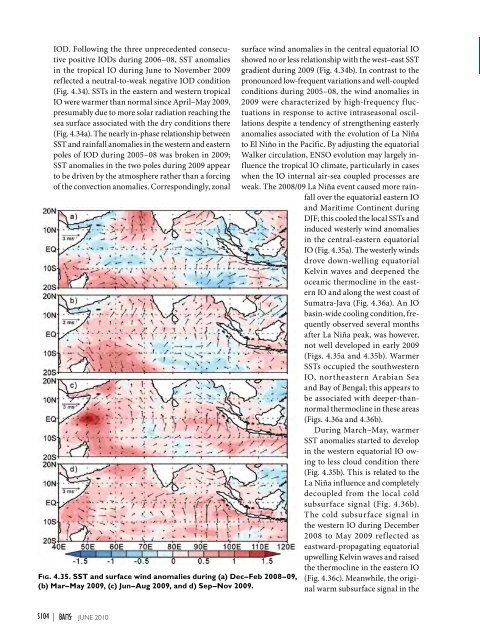Create successful ePaper yourself
Turn your PDF publications into a flip-book with our unique Google optimized e-Paper software.
IOD. Following the three unprecedented consecutivepositive IODs during 2006–08, SST anomaliesin the tropical IO during June to November <strong>2009</strong>reflected a neutral-to-weak negative IOD condition(Fig. 4.34). SSTs in the eastern and western tropicalIO were warmer than normal since April–May <strong>2009</strong>,presumably due to more solar radiation reaching thesea surface associated with the dry conditions there(Fig. 4.34a). The nearly in-phase relationship betweenSST and rainfall anomalies in the western and easternpoles of IOD during 2005–08 was broken in <strong>2009</strong>;SST anomalies in the two poles during <strong>2009</strong> appearto be driven by the atmosphere rather than a forcingof the convection anomalies. Correspondingly, zonalFig. 4.35. SST and surface wind anomalies during (a) Dec–Feb 2008–09,(b) Mar–May <strong>2009</strong>, (c) Jun–Aug <strong>2009</strong>, and d) Sep–Nov <strong>2009</strong>.surface wind anomalies in the central equatorial IOshowed no or less relationship with the west–east SSTgradient during <strong>2009</strong> (Fig. 4.34b). In contrast to thepronounced low-frequent variations and well-coupledconditions during 2005–08, the wind anomalies in<strong>2009</strong> were characterized by high-frequency fluctuationsin response to active intraseasonal oscillationsdespite a tendency of strengthening easterlyanomalies associated with the evolution of La Niñato El Niño in the Pacific. By adjusting the equatorialWalker circulation, ENSO evolution may largely influencethe tropical IO climate, particularly in caseswhen the IO internal air-sea coupled processes areweak. The 2008/09 La Niña event caused more rainfallover the equatorial eastern IOand Maritime Continent duringDJF; this cooled the local SSTs andinduced westerly wind anomaliesin the central-eastern equatorialIO (Fig. 4.35a). The westerly windsdrove down-welling equatorialKelvin waves and deepened theoceanic thermocline in the easternIO and along the west coast ofSumatra-Java (Fig. 4.36a). An IObasin-wide cooling condition, frequentlyobserved several monthsafter La Niña peak, was however,not well developed in early <strong>2009</strong>(Figs. 4.35a and 4.35b). WarmerSSTs occupied the southwesternIO, northeastern Arabian Seaand Bay of Bengal; this appears tobe associated with deeper-thannormalthermocline in these areas(Figs. 4.36a and 4.36b).During March–May, warmerSST anomalies started to developin the western equatorial IO owingto less cloud condition there(Fig. 4.35b). This is related to theLa Niña influence and completelydecoupled from the local coldsubsurface signal (Fig. 4.36b).The cold subsurface signal inthe western IO during December2008 to May <strong>2009</strong> ref lected aseastward-propagating equatorialupwelling Kelvin waves and raisedthe thermocline in the eastern IO(Fig. 4.36c). Meanwhile, the originalwarm subsurface signal in theS104 | juNE 2010
















